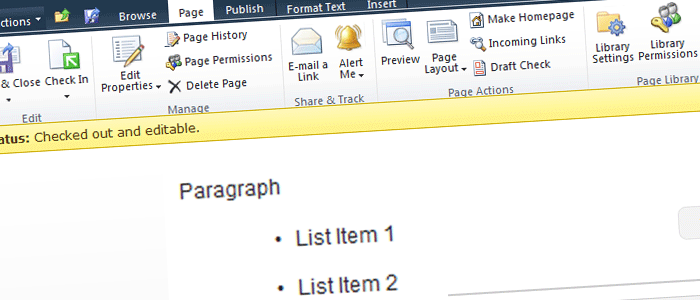[Image via Steve Ottenad]
In SharePoint as in life, a page is a place that stores information in a visible format. In life, you might use ultra glossy paper for your photography opus and parchment for your diplomas. The same holds true for SharePoint, minus the parchment paper, which is hopefully coming in Office 2015. Anyways, there are two primary types of pages: site pages and application pages.
The Site Page:
There are three types of site pages: the publishing page, the wiki page and the web part page.
- Publishing Page: A page that displays text, images, web parts etc in a structured layout. If you don’t want your content sprawling about all willy-nilly and/or you need to approve pages before they’re made public, this baby is for you. Unless you’re using a Team Site, in which case: tough luck. Publishing pages are specific to publishing sites.
- Wiki Page: A page where everything on it can be edited by multiple authors. If you’re in a team site, this is the default page. If you’re in a publishing site, you can add a wiki page from a wiki library. If you’re in an enterprise wiki site, even the homepage is a wiki page.
- Web Part Page: A page for web part and web parts only, contained in web part zones. These pages are dynamic and useable by all SharePoint sites. If you need to display information, and don’t need anyone else to futz with it, and also don’t need any fancy ole wrappers or descriptive text, this is the page for you.
Okay, cool. But from whence cometh such beauty?
Glad you asked. OOTB, a site page gets its look, feel and components from a template page. But, once a site page is customized, a new dedicated template is added to the content database. By customized, MSFT does NOT mean “add all the inline server code you want.” Stay away from that junk, people. Or, if you absolutely must have it, get your admin to add a pageparserpath setting in web.config. But you’re an end user, so just…stick to what your mama gave you, okay?
The Application Page
Honestly, you don’t need to know what this is, but I believe in freedom of (most) information, so Imma tell you: the application page is like the wrapper around a given SharePoint app. They are lawless places where vigilante justice rules, and as such support in-line coding and do not support lamestream functionality like web parts.
Things that are not pages but kind of look like them:
Word documents you can open and edit in your browser, Infopath browser-enabled forms, html and aspx pages you’ve created in SPD. Oh wait—you’re a novice end user. SPD is for developers! And by “developers,” I mean people who’ve been using SharePoint for more than a week. So wait a week!
Kidding. If you wait a week, you’ll dive into document libraries. Oxygen tank highly recommended.
Further Resources:
- Get the Point’s “Overview of SharePoint 2010 Pages”
- Vanessa William’s “Types of Web Pages in SharePoint 2010“
Share the post "NEUGS Part 5: A SharePoint Page Is Like the Box Holding the Chocolates"

 Follow
Follow